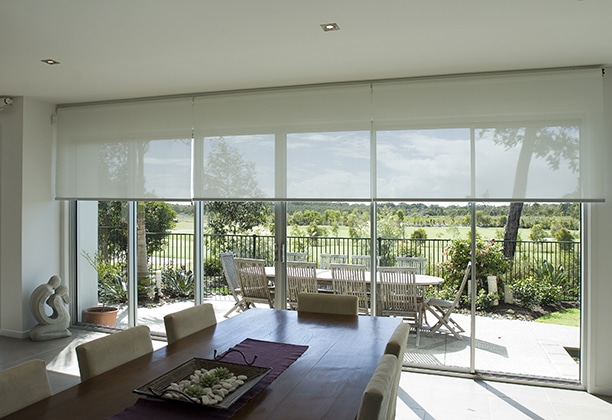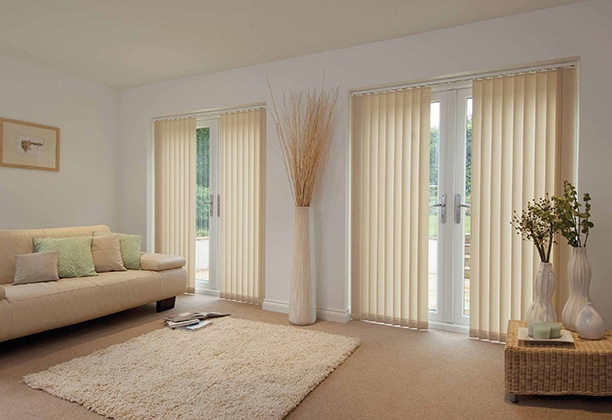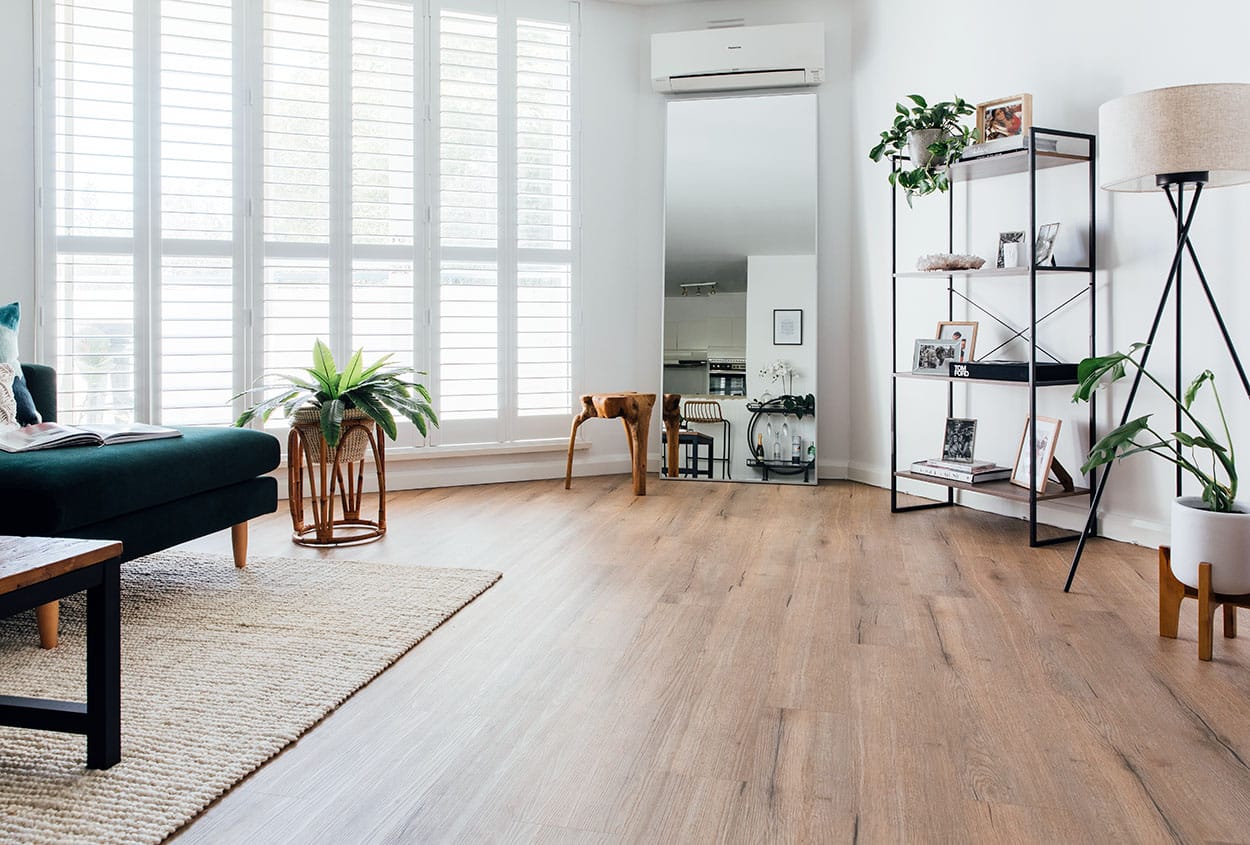Our Window Furnishing Solutions
High-quality Australian-made blinds & window furnishings – perfect for Australian conditions. They are designed to optimise light, manage privacy and improve thermal control. Achieve stunning results that will withstand time, meet trends, and place the finishing touches to the look and feel of your home.
There are many factors to consider when selecting the right type of window treatment for your home, both aesthetically and functionally. Blinds can block-out your neighbours, reflect heat in summer and retain warmth in winter. Select a blind that suits your needs but also complements your space.
If your window allows, consider recessing the blinds within the frame for a seamless and unobtrusive look. To increase the appearance of the size of the window, consider face fixing them and extending your blinds either side of the frame, this can make a narrow window appear wider and allow maximum light into the room. A little tip to remember, if selecting a light filtering blind, the darker the blind, the more light is let in, which is opposite to what you may think.
Call 1300 FLOORX for your nearest store for a free in-home consultation. Read our guide below on how to make the decision on which window furnishings will suit your needs.
Types of Window Furnishings
 Roller Blinds
Roller Blinds
One of the most common types of treatments applied to new homes which are often called “Holland Blinds” too. They are a versatile, hardy and often economical way to furnish a window. As popularity increased, so too did the variety and range of finishes and fabrics that roller blinds are available in.
Roller blinds are attached to the window frame and provide the interior with a seamless and slick aesthetic. They are easily manoeuvred and functional. They also protect the flooring and furnishings from strong sunlight which can damage these pieces. One thing that is to be considered when choosing blinds is the lack of flexibility when adjusting levels of light into a space.
Blinds are not designed to allow for filtered or partial light. They are generally all the way up, or all the way down. The exception here is when there is a two-layered system comprising of a sheer fabric and then a block out, allowing for more control and dual functionality. Roller blinds are a contemporary addition to a home. They don’t detract from more decorative features in a home because of their simple design.
To soften roller blinds, sheers or a drape can be placed in front to create a more classic feel. To blend the blinds and make them even less of a feature, select a colour which is closest to the paint colour surrounding it. For a more dramatic look, charcoal and grey blinds are also appealing. To find the balance between drama and blending in, there are softer, more textural options which can be appealing. While roller blinds can be physically installed in most instances, they won’t look at home in a period style property.
 Panel Blinds
Panel Blinds
These are similar to a roller blind but move on fixed panels in a horizontal system, rather than a vertical line. They provide more flexibility in a sense of controlling light into a room, but they are more limited in the way they cannot be fully retracted like a roller blind which hides itself almost completely in a roll. Panel blinds stack to the left or right of a window or glass door. Because of this, they are visually more suited to a larger, full length window, or several windows/ glass doors in a row as they can block some light by the process of stacking. Panel blinds can be seen in the same way as roller blinds.
They are most suited to contemporary homes due to their slick and modern appearance. They are not decorative treatments as such, unless the more textured fabrics are used. Try to ascertain what it is the client wants the blinds to do in terms of appearance. If they already have many features in the room, (wallpapers, patterns, colours for example) then a simple flat colour would be best. If the room is plain in its décor and the client would like to inject some interest, then perhaps steering them towards darker colours, colours aside from neutrals and textures can be done successfully.
 Roman Blinds
Roman Blinds
This classic style of blind is more structured than a roller or panel blind. With a focus on fabric, they add a casual and classic ambience to a space, therefore would be suitable for homes which celebrate character by the way of period features or classic architectural details. They are generally structured with a thin timber baton which can be pulled up towards the ceiling with a cord.
They are practical for deeper windows and can add interest and style to an interior. They can be helpful in providing privacy and thermal qualities when down, however unless they have a sheer behind them they are not as flexible as slatted designs in this regard. Roman blinds are a softer alternative to the more mechanical blind options of panel, roller and verticals.
They work well in a broad range of spaces, from coastal and country homes through to period and more classically designed spaces. The flexible design is a chic addition to any room. Depending on the level of detail and colour of the fabric, their impact will vary. Coastal properties for example may choose a linen-look fabric to add a textural element, while a period home may look best with a stripe or floral pattern. Try to draw from the existing space if it’s already decorated. Is there a colour which can be referenced from a chair fabric, a rug or artwork?
If the room is a blank canvas, the client will need to decide if the Roman blinds should be a feature or not. If they want it to be a feature, choose a colour which is different from the paint around it. Darker fabrics and colours will add more impact. Patterns such as floral evoke a classic feel, stripes can be both modern and traditional and are not as “pretty or feminine” as a floral and a geometric pattern is more modern in its appearance. If they don’t want it to become a feature, select a fabric similar to the paint colour.
 Vertical Blinds
Vertical Blinds
Vertical blinds are a slatted design which also move on a horizontal system. As many slatted systems do, vertical blinds offer a good amount of control when it comes to privacy and light manipulation. This is because they can be adjusted to allow different levels of light in through the angling of the slats, which is also helpful for privacy in a home or office situation.
While they are not seen as contemporary in design as other blind styles they do have their positive attributes and are well suited to some interior settings. Vertical blinds while very practical, are not seen as a cutting edge visual solution for window treatments. They are well suited to commercial spaces and more traditional, newer homes. In a design sense, they are not “trend” additions. There are many colours and finishes available however and choosing a colour will be much the same as a roller or Holland blind.
 Shutters
Shutters
For a home requiring a classic look, shutters are often an option. The stylish window treatment, often made from timber or a timber-look material, provide the home with good control of light and privacy as all slatted designs do. They look particularly fantastic in period, coastal and country homes, or homes trying to achieve that look in a more contemporary setting.
It should be noted that they require a certain amount of space around a window to be attached in the return and they can also be slightly restricting of light- so if you are concerned about your space already being too dark, this may not be the answer for you.
Is there anything more classic than a white shutter? White is a very popular option for shutters, and for good reason, they are elegant, crisp and don’t weigh too heavily in a space. They look particularly lovely paired back with soft grey walls. There are also timber stained shutters which are also gorgeous. The timber coloured shutter adds a warmer and more contemporary feel to the space. They work best in larger, more casual and contemporary spaces. Remember there is a lot of timber involved, so there is variety and balance when the walls are painted a nice fresh white.
 Venetian Blinds
Venetian Blinds
A timeless and sophisticated application to provide a contemporary look. Similar to a shutter appearance but a more affordable alternative, the Venetian blinds have ability to tilt to control light direction and provide excellent privacy. They come in a varying slat widths for different looks. Options available are the timber or timber look products which provide warmth to a living room and are versatile for other parts of the home such as kitchen, laundry and bathrooms. They are easy to clean.
An aluminium venetian is a classic modern option which is available in many colours to complement a room. They are a perfect application for a small room as the horizontal angle of the blind gives the feeling of a larger area.
 Pelmets
Pelmets
Pelmets are a structure which is built at the top of a blind or curtain which is designed to hide the top of the window treatment. Some systems, such as drapery have less than appealing mechanisms so this can be a visually interesting way to conceal this. They are generally made from timber and can either be left this way treated, or can be upholstered to complement a fabric drapery design.
Pelmets are available in a few different options, from timber to upholstered as mentioned above. Quite simply, the best option is to try and match the pelmet to the material the blinds or drapes are made from. If you have a more contemporary design, such as a roller blind, a painted timber option is best. If you have a traditional drape, the box can be upholstered in either the same fabric or that of a complimentary shade. If the fabric has multiple tones, pick the most dominant if the client does not want to use the same fabric for the pelmet. Choosing an alternative fabric will bring more attention to the pelmet, which the client should be aware of. Upholstered pelmets are also considered in the design world as being quite a traditional “look”.
 Drapes
Drapes
Drapery can add instant mood to an interior, from glamour, elegance and sophistication through to whimsical depending on the style of drapes and fabrics selected. The options for drapes are endless and the benefits are also plentiful. Drapes, which run on a horizontal tracking system, also provide a space with fantastic thermal properties, allowing the sun to be blocked in summer successfully. It also helps control interior heat in winter from escaping out of the windows. Both of these factors mean you can effectively lessen both your heating and air-conditioning bills because of the benefits of drapes.
Drapes are not for every interior though. They provide a more “fussy” aesthetic which some people are not fond of and they can use a lot of fabric, meaning they are not always the most economical solution. As stated above, drapes are not for every space, but when they are installed in the right interior, the look can be stunning.
Period homes and traditional or classically designed homes look beautiful when adorned with drapery. A soft look can be achieved by using linens and lighter fabrics. Older, period homes can hold richer colours and patterns as well as details such as trims, borders and decorative tie-backs. Remember to consider the fabric as a whole piece, but also how it will fall and drape. Organic patterns such as florals and linens work well because they don’t fight the natural fall of the fabric and the direction it will push the pattern of the fabric. Stripes are a little more difficult as they can distort the appearance of the pattern when pushed back. It’s nice to reference the fabric pattern back with a cushion, throw or upholstered chair, although again, this can be seen as a more traditional look.